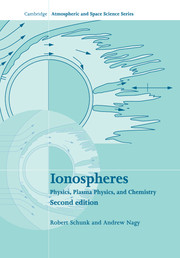Book contents
- Frontmatter
- Contents
- Chapter 1 Introduction
- Chapter 2 Space environment
- Chapter 3 Transport equations
- Chapter 4 Collisions
- Chapter 5 Simplified transport equations
- Chapter 6 Wave phenomena
- Chapter 7 Magnetohydrodynamic formulation
- Chapter 8 Chemical processes
- Chapter 9 Ionization and energy exchange processes
- Chapter 10 Neutral atmospheres
- Chapter 11 The terrestrial ionosphere at middle and low latitudes
- Chapter 12 The terrestrial ionosphere at high latitudes
- Chapter 13 Planetary ionospheres
- Chapter 14 Ionospheric measurement techniques
- Appendix A Physical constants and conversions
- Appendix B Vector relations and operators
- Appendix C Integrals and transformations
- Appendix D Functions and series expansions
- Appendix E Systems of units
- Appendix F Maxwell transfer equations
- Appendix G Collision models
- Appendix H Maxwell velocity distribution
- Appendix I Semilinear expressions for transport coefficients
- Appendix J Solar fluxes and relevant cross sections
- Appendix K Atmospheric models
- Appendix L Scalars, vectors, dyadics, and tensors
- Appendix M Radio wave spectrum
- Appendix N Simple derivation of continuity equation
- Appendix O Numerical solution for F region ionization
- Appendix P Monte Carlo methods
- Index
Chapter 10 - Neutral atmospheres
Published online by Cambridge University Press: 22 January 2010
- Frontmatter
- Contents
- Chapter 1 Introduction
- Chapter 2 Space environment
- Chapter 3 Transport equations
- Chapter 4 Collisions
- Chapter 5 Simplified transport equations
- Chapter 6 Wave phenomena
- Chapter 7 Magnetohydrodynamic formulation
- Chapter 8 Chemical processes
- Chapter 9 Ionization and energy exchange processes
- Chapter 10 Neutral atmospheres
- Chapter 11 The terrestrial ionosphere at middle and low latitudes
- Chapter 12 The terrestrial ionosphere at high latitudes
- Chapter 13 Planetary ionospheres
- Chapter 14 Ionospheric measurement techniques
- Appendix A Physical constants and conversions
- Appendix B Vector relations and operators
- Appendix C Integrals and transformations
- Appendix D Functions and series expansions
- Appendix E Systems of units
- Appendix F Maxwell transfer equations
- Appendix G Collision models
- Appendix H Maxwell velocity distribution
- Appendix I Semilinear expressions for transport coefficients
- Appendix J Solar fluxes and relevant cross sections
- Appendix K Atmospheric models
- Appendix L Scalars, vectors, dyadics, and tensors
- Appendix M Radio wave spectrum
- Appendix N Simple derivation of continuity equation
- Appendix O Numerical solution for F region ionization
- Appendix P Monte Carlo methods
- Index
Summary
Neutral atmospheres play a crucial role with regard to the formation, dynamics, and energetics of ionospheres, and therefore, an understanding of ionospheric behavior requires a knowledge of atmospheric behavior. A general description of the atmospheres that give rise to the ionospheres was given in Chapter 2. In this chapter, the processes that operate in upper atmospheres are described, and the equations presented have general applicability. However, the discussion of specifics is mainly directed toward the terrestrial upper atmosphere (see Chapter 2 for a limited description of other solar system neutral atmospheres) because our knowledge of this atmosphere is much more extensive than that for all of the other atmospheres (i.e., other planets, moons, and comets).
Typically, the lower domain of an upper atmosphere is turbulent, and the various atomic and molecular species are thoroughly mixed. However, as altitude increases, molecular diffusion rapidly becomes important and a diffusive separation of the various neutral species occurs. For Earth, this diffusive separation region extends from about 110 to 500 km, and most of the ionosphere and atmosphere interactions occur in this region. At higher altitudes the collisional mean-free-path becomes very long and the neutral particles basically follow ballistic trajectories. For the case of light neutrals, such as hydrogen and helium, and more energetic heavier gases, some of the ballistic trajectories can lead to the escape of particles from the atmosphere.
The topics in this chapter progress from the main processes that operate in the diffusive separation region of an upper atmosphere to the escape of atoms from the top of the atmosphere. First, atmospheric rotation is discussed because it has a significant effect on the horizontal flow of an atmosphere.
- Type
- Chapter
- Information
- IonospheresPhysics, Plasma Physics, and Chemistry, pp. 289 - 334Publisher: Cambridge University PressPrint publication year: 2009
- 1
- Cited by

